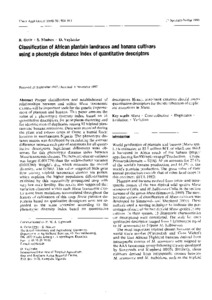| dc.contributor.author | Ortiz, R. |
| dc.contributor.author | Madsen, S. |
| dc.contributor.author | Vuylsteke, D. |
| dc.date.accessioned | 2019-12-04T11:33:25Z |
| dc.date.available | 2019-12-04T11:33:25Z |
| dc.date.issued | 1998 |
| dc.identifier.citation | R. Ortiz, R., Madsen, S. & Vuylsteke, D. (1998). Classification of African plantain landraces and banana cultivars using a phenotypic distance index of quantitative descriptors. Theory of Applied Genetics, 96, 904-911. |
| dc.identifier.issn | 0040-5752 |
| dc.identifier.uri | https://hdl.handle.net/20.500.12478/5672 |
| dc.description.abstract | Proper classification and establishment of relationships between and within Musa taxonomic clusters will be important tools for the genetic improvement of plantain and banana. This paper assesses the value of a phenotypic diversity index, based on 16 quantitative descriptors, for germplasm clustering and for identification of duplicates among 92 triploid plantain and banana accessions. Data were recorded during the plant and ratoon crops at Onne, a humid forest location in southeastern Nigeria. The phenotypic distance matrix was developed by calculating the average difference between each pair of accessions for all quantitative descriptors. Significant differences were observed for this phenotypic distance index between Musa taxonomic clusters. The between-cluster variance was larger (0.001779) than the within-cluster variance (0.001380). Wright's ϕFS, which measures the overall diversity, was 0.5663. This value suggested little gene flow among triploid taxonomic clusters via pollen, which explains the higher population differentiation exhibited by this vegetatively propagated crop with very low male fertility. The results also suggested that variation observed within each Musa taxonomic cluster arose from mutations accumulated throughout the history of cultivation of this crop. Some putative duplicates based on qualitative descriptors were not regarded as the same accession according to the phenotypic diversity index based on quantitative descriptors. Hence, gene-bank curators should assess quantitative descriptors for the identification of duplicate accessions in Musa. |
| dc.language.iso | en |
| dc.subject | Plantains |
| dc.subject | Bananas |
| dc.subject | Gene Banks |
| dc.subject | Suckers |
| dc.subject | Musa |
| dc.subject | Genetic Resources |
| dc.subject | Genomes |
| dc.title | Classification of African plantain landraces and banana cultivars using a phenotypic distance index of quantitative descriptors |
| dc.type | Journal Article |
| dc.description.version | Peer Review |
| cg.contributor.affiliation | Royal Veterinary and Agricultural University, Denmark |
| cg.contributor.affiliation | International Institute of Tropical Agriculture |
| cg.coverage.region | Africa |
| cg.coverage.region | West Africa |
| cg.coverage.country | Nigeria |
| cg.isijournal | ISI Journal |
| cg.authorship.types | CGIAR and advanced research institute |
| cg.iitasubject | Banana |
| cg.iitasubject | Plantain |
| cg.accessibilitystatus | Limited Access |
| local.dspaceid | 104952 |

